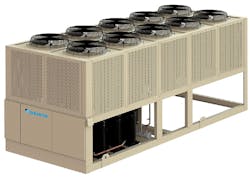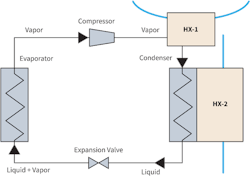Using Heat Recovery to Improve Chiller Efficiency
By PAUL CRISMAN
Daikin Applied
Minneapolis MN
Today in the HVACR industry, chillers are typically considered cold water providers. But with advancements in technology, chillers are now being optimized for heat recovery, too. In a standard building, HVACR equipment accounts for a substantial part of the total energy consumption, and heat recovery offers a new way for facility managers and building owners to reduce HVACR energy use and costs.
Heat recovery reclaims energy normally rejected during heating and cooling processes from air or water applications using an enthalpy wheel or energy recovery ventilator. The engineering concept is to extract the otherwise wasted energy of exhaust air and use it to preheat cold outdoor air. In applications with simultaneous heating and cooling, heat recovery is an especially effective method for reducing energy.
Understanding the Technology
In air-cooled chillers, the heat exchanger is called a desuperheater, which rejects building load heat to the atmosphere through condenser fans during normal operation. In heat recovery mode, hot refrigerant gas leaves the compressor and enters the heat exchanger where the energy in the refrigerant gas transfers to the incoming hot water loop. As a result, the refrigerant is pre-cooled prior to entering the condenser coil section, reducing fan energy and further improving energy efficiency.
In water-cooled chillers, the heat recovery process is slightly different. Instead of fans, water-cooled chillers reject heat to a condenser loop, which then rejects heat into the atmosphere through a cooling tower. To do this, water-cooled chillers require a special condenser barrel that can transfer heat to the condenser loop and reject heat when the chiller operation does not require heat recovery.
While the efficiency improvements of heat recovery may make it seem like a necessity for any chiller application, there are additional design considerations required for this technology. Chiller heat recovery requires greater infrastructure and controls to ensure the leaving water temperature does not influence the refrigerant temperature limits. The controller uses algorithms to evaluate refrigerant pressures, outside air temperature and other inputs to determine the appropriate output signal for loop control. As conditions change, the controller sends a signal to modulate the device selected by the engineer.
Typical Applications
Heat recovery effectiveness varies based on building design, geographical location and load profile. Not all projects are a great fit for heat recovery applications, it is important to review the building design to determine the viability of integration. However, as the emphasis on energy efficiency and environmental considerations continues to develop, heat recovery will soon be a regular consideration for retrofits and building designs. Common applications for heat recovery include hotels, schools and healthcare facilities.
The hospitality industry has the highest demand for heat recovery due to domestic hot water needs, high utility rates and periods of simultaneous heating and cooling. Educational buildings vary widely in design due to the large variations in space types (classrooms, labs, gymnasiums, etc.) and can sometimes require large amounts of domestic hot water. That makes them a good candidate for heat recovery, as well.
Healthcare facilities often use large amounts of energy to condition their spaces at specific temperatures. Additionally, to achieve specific temperatures, most healthcare facilities require heating and cooling from their HVAC systems. The need for both heating and cooling is even increasing at some healthcare facilities, as trends such as allowing patients to control their individualized room comfort pose energy consumption issues where heat recovery can be a solution.
Saving While Operating
Energy savings play a large role when deciding to install a heat recovery application, since it requires additional capital investment. The standard increase in full load Energy Efficiency Ratio (EER) for various sized scroll compressor chillers when switching from a standard packaged unit to a heat recovery unit is about 0.5 EER. This is due to the condenser fans running for fewer hours as the hot refrigerant vapor is pre-cooled by transferring heat to the hot water loop prior to entering the condenser coil.
When comparing part load operation, there is also an expected increase in efficiency. However, at low loads there are relatively lower efficiency gains as condenser fan operation time is already reduced during part load operation to maintain head pressure. So in addition to a full-load EER increase, a chiller would also have an integrated part load value (IPLV) equal to or greater than a normal chiller without heat recovery.
Heat Recovery’s Bright Future
At Daikin, we continue to see more of an emphasis placed on equipment and system efficiency than ever before, and heat recovery is an excellent solution for these demands. In some cases, heat recovery can even help with downsizing heating equipment. These efficiency advantages are applicable to chillers across multiple HVAC markets.
While it can be tough for some building owners to look past the upfront costs of installing heat recovery, applications can easily make up the cost over time through energy savings. In addition, technological innovations are making it easier than ever for building owners to implement heat recovery. Chillers like Daikin Applied’s Trailblazer® air-cooled scroll chiller are available with controls optimized for heat recovery. Going forward, we will see more chillers with heat recovery selected in the industry, as facility managers and building owners realize the potential benefits of this feature.
Based in Verona VA, Paul Crisman is a chiller applications engineer at Daikin Applied Americas. Certified in air conditioning and refrigeration studies and well-versed in sustainability practices, earlier this year he published a white paper, Delivering Hot Water with a Chiller, now available at www.daikinapplied.com.




